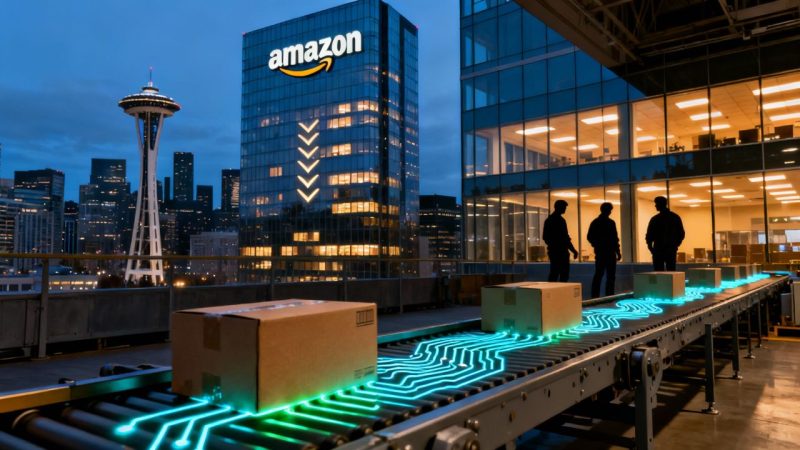
Amazon just lobbed a big number into an already jittery labor market: roughly 14,000 corporate jobs cut, with executives signaling that more “efficiency gains” are still on the table. That’s about 4% of Amazon’s 350,000 white‑collar workforce, the first tranche in what could be a larger reshaping as the company pours an eye‑popping sum—up to $118 billion this year—into AI and cloud infrastructure. The memo framing this as “flattening layers” and boosting “ownership” reads like standard tech downsizing boilerplate. But the stakes are more than internal org charts. It’s about what happens when the world’s second‑largest private employer decides “the most transformative technology since the internet” is a license to do more with fewer people.
Amazon confirmed the cuts in a company blog post from HR chief Beth Galetti, emphasizing that affected staff will get 90 days to find internal roles and severance if they don’t. The rationale: to run “more leanly” and reorganize around generative AI, where Amazon insists the future is moving—and quickly. CEO Andy Jassy has been blunt for months that AI will reduce corporate headcount, even as it creates different jobs elsewhere in the company’s ecosystem. The subtext: this isn’t a one‑off. It’s a new operating philosophy.
The New Efficiency Math
Let’s separate the accounting from the accountability. On the accounting: the macro adds up. Amazon spent 2022–2023 trimming 27,000 roles. Now it’s swinging again while committing tens of billions in capex for data centers and AI capacity—an arms race against Microsoft and Google. The Financial Times pegs this year’s capital expenditures as high as $118 billion, largely AI infrastructure. Investors have been primed for this “AI opex today, operating leverage tomorrow” story, and management’s line about “removing layers” fits the playbook.
On the accountability: who bears the cost of these efficiency gains? The people being told to relocate to hubs, to come back five days a week, and now to compete internally for fewer seats in a game of corporate musical chairs. AI boosters talk about productivity dividends; workers experience them as job risk and wage pressure until the next “new types of jobs” actually materialize at scale.
The Quiet Cultural Revolution Inside Big Tech
“Operate like the world’s largest startup” is a flattering way to describe unglamorous work: de‑layer, centralize decisions, move faster by making fewer people responsible for more. It’s also a cultural reset after the pandemic hiring spree. Meta, Microsoft, Google—everyone is tightening while proclaiming AI‑first ambition. But Amazon’s scale makes it a bellwether. When Amazon signals that hundreds of thousands of AI “agents” will touch every function, it’s not sci‑fi—it’s a roadmap for how white‑collar tasks get modularized, monitored, and eventually automated or “copiloted.”
The Guardian’s summary captured the tension: strong results, aggressive AI spending, and still layoffs—because the “most transformative technology since the internet” changes how companies define “necessary” jobs. That’s not just a Seattle story; UK workers are bracing for the spillover, with union leaders warning of losses and pointing to the ethical optics of record profits alongside cuts as per The Guardian.
What This Means Beyond Amazon
- Labor market signaling: When Amazon trims, startups and midsize firms often follow. Expect more C‑suite memos sanctifying reductions in the name of AI agility as per CNBC.
- Policy lag: The U.S. remains behind on guardrails for AI‑driven workforce transitions—think wage insurance pilots, rapid‑reskilling tied to employer tax incentives, portable benefits for dislocated white‑collar workers. We’ve debated these ideas for blue‑collar automation for a decade; white‑collar is here now.
- Antitrust irony: Amazon argues it must spend aggressively to keep up in AI, even as regulators scrutinize Big Tech scale. If AI becomes the moat, the cost to compete climbs, consolidating power—and policymaking—as a byproduct of “innovation.”
- Democratic norms lens: A healthy democracy depends on broad‑based economic dignity. When productivity gains accrue to capital while risks accrue to labor, the cynicism that poisons politics deepens. The fix isn’t to stall AI; it’s to demand that the companies most able to shape the transition share more of the upside with the people they’re displacing.
The Narrative Amazon Wants—And The One It Needs
Amazon wants this framed as renewal: fewer managers, more builders, bigger bets. There’s truth there. But the more honest—and durable—narrative would include concrete commitments that map efficiency to equity. Examples: automatic internal placement guarantees for high‑performers where feasible; transparent AI‑related role maps so employees can see pathways, not just pink slips; funded training with job‑linked placement targets; and a public reporting framework on AI‑enabled productivity and its impact on headcount and wages.
The company doesn’t have to do this. It should. Because the story of AI that resonates beyond Wall Street is not just faster, cheaper, better—it’s fairer. And if Amazon wants to be the platform for the next economy, it has to be more than the platform for the next layoff memo.
Bottom Line
This is a big, first cut in a longer restructure. The logic is coherent; the human cost is real. AI can be a shared prosperity technology, but only if the institutions deploying it design for that. Amazon is telling us the future is arriving fast. The question is whether workers get a ticket—and a seat—on that train.
